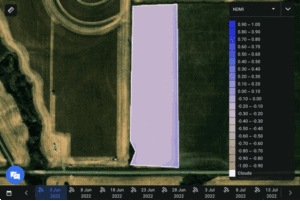
The NDRE index helps monitor the health of crops by measuring the amount of chlorophyll in the plants. Sick and damaged plants do not produce enough chlorophyll. Here we can see the growing season went quite well and by October 1, the crops were successfully harvested on the studied cornfield. (Credit: EOS Data Analytics)
Despite an extreme drought in northwestern Iowa throughout summer 2022, the overall corn condition was better than in the previous two years. EOS Data Analytics explored the causes of these phenomena and explained how Iowa farmers tackle such prolonged dry conditions.
During the last few decades, climate change had been bringing positive effects on crop growth and reproduction. However, it’s now reaching a point where it causes more harm than good. Growing temperatures during summer heat waves will gradually increase the chances of failed corn pollination, the most critical stage of corn pollination affecting the size of the yield.
To make sure corn pollination goes well, farmers must ensure sufficient moisture in the soil and optimal air temperatures. This is what remote sensing data allows farmers to track and even anticipate.
To demonstrate it, EOS Data Analytics studied a cornfield between Danbury and Sioux City in northwestern Iowa. Data provided by EOSDA Crop Monitoring, an online satellite-based precision agriculture platform for field monitoring, reveals rainfalls prior to the 2022 summer drought were able to saturate the soil with moisture well, and overnight temperatures during the drought were low enough to keep that moisture in the soil.
There are no upcoming events.
